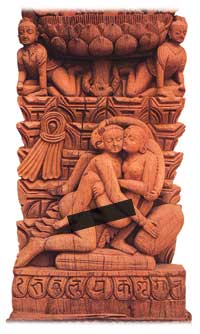 It is hard to tell today that we are a people whose ancestors contributed valuable research data to Prof Vatsyayana so he could write his bestselling book, The Kamasutra. It is clear as we look around us today that we are only a shadow of the outstanding and upright people we once were. So let us take the opportunity of International Valentine Day and our own Annual Mating Season this week to remember past masters in the art of love.
It is hard to tell today that we are a people whose ancestors contributed valuable research data to Prof Vatsyayana so he could write his bestselling book, The Kamasutra. It is clear as we look around us today that we are only a shadow of the outstanding and upright people we once were. So let us take the opportunity of International Valentine Day and our own Annual Mating Season this week to remember past masters in the art of love. Those were the days when we didn't beat around the bush when it came to birds and bees: we got straight to the point. Of course, our women then, as today, pretended not to know what that point was exactly, but we knew they knew that we knew it was only a question of time before they got the drift.
Much of the valuable ornithological and apiarian data we Nepalis amassed through the millennia was lost to posterity because Prof Vatsyayana decided that it was too risqu? for his book, and threw it into the bin. Luckily, our ancestors had backup hard drives from which they rescued facts and figures and promptly carved them into the eaves of Kathmandu Valley temples where they have become the backbone of our tourism industry today.
Some of the technical details of this priceless corpus of research may be way over our heads, but all you need is a pair of powerful binoculars and a secret vantage point in one of the Valley's three temple squares to unlock the secrets of our holy architecture (From sanskrit: "arch"=dirty, and "itecture"=stuff).
These erections give us a peek into what our ancestors did for fun and games in prehistoric times while laying the foundations of our civilisation. And it is obvious from a cursory perusal of the evidence on display that we as a people loved to tie ourselves into knots. This was not just a way to mix pleasure as they went about their business, but also to follow a strenuous exercise regimen closely integrated with three other ancient sports-yoga, wrestling and kabbadi.
No wonder, then, that some of the x-rated struts on our temples show erotica that look uncannily like Greco-Roman wrestling. Imagine all the extra calories they burnt when protagonists in the same weight class grabbed each other in firm half-nelsons, pulled each other over with gut-wrenches and ankle-laces, followed by vice-like body-locks.
In a manoeuvre that the World Wrestling Federation now calls "Reversal" (which earns the player three bonus points) the passive encounter ends when the man underneath completely reverses his position and comes to the top position. The other below-the-belt move is called the crotch-lift, and a WWF manual says this position can be employed by the aggressor to execute holds with his or her arms and legs, leading to front head-locks with amplitude.
We don't know what the final outcome of these bouts were, because our ancestors had such fertile imaginations that they soon ran out of temples to depict them on. But what we do know for a fact is that our forebears also loved to wrestle with sheep, water buffalo and other semi-mythical fauna in order to test their strength and stamina. In fact, they were such eager sportsmen that they would wrestle with just about anything that moved. They wrestled in groups, and sometimes they even wrestled with themselves.
Following this grand tradition, it is important for us this Valentine's Day to value and preserve our grand traditions by paying silent homage to the acrobats who laid the groundwork of the society we are now proud to call our own. And without their seminal contribution, we can say with a great deal of certainty that we would not be here today to pen these lines of tribute from the bottoms of all our hearts.



